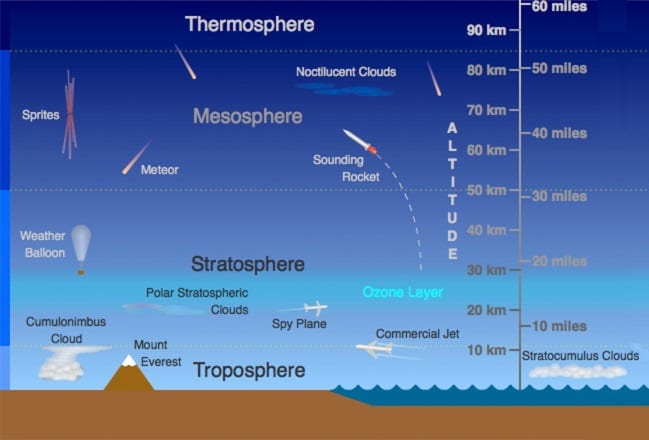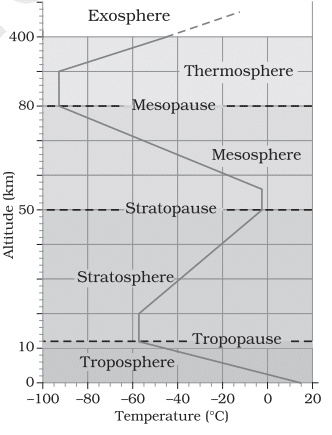April 8, 2019
Layers of Atmosphere of the Earth
Contents
Layers of Atmosphere of the Earth
- The atmosphere is composed of gases, water vapor, and dust particles.
- Mixer of dust particles and water vapor is called aerosol.
- It receives Incoming solar energy from the sun giving rise to climate.
- We actually live at the bottom of this indefinite layer of the atmosphere.
- One estimate puts this limit at about 600 miles (950 km) above sea level.
- 99% of the total mass of the atmosphere is confined to a height of 32 km from the earth’s surface.

Composition of Atmosphere of the Earth
- The proportion of Gases changes in the higher layers of the atmosphere.
- Oxygen will be almost in negligible quantity at the height of 120 km.
- Similarly, carbon dioxide and water vapor are found only up to 90 km from the surface of the earth.
Water Vapor
- It is constituting 2% to 4% of the total volume.
- 90% of moisture content in the atmosphere exists within 6 km of the surface of the earth.
- Water vapor plays a significant role in the insulating action, of the atmosphere.
- It absorbs long-wave terrestrial radiation and part of the incoming solar radiation.
- Water vapor is the source of precipitation and clouds.
Dust Particles
- It consists of sand particles, pollen grains, small organisms, soot, and ocean salts.
- These solid particles perform the function of absorbing, reflecting, and scattering radiation.
- It is responsible for the orange and red colors at sunset and sunrise.
- The blue color of the sky is due to selective scattering by dust particles.
- Dust particles are an important factor in forming clouds, fog, and hailstones.
Layers of Atmosphere of the Earth

Layers of Atmosphere of the Earth
- The atmosphere consists of different layers with varying densities and temperatures.
- Density is the highest near the surface of the earth and decreases with increasing altitude.
- The column of the atmosphere is divided into 5 different layers depending upon the temperature condition.
Troposphere
- The troposphere is the lowermost layer of the atmosphere.
- Its average height is 13 km.
- It extends roughly to a height of 8 km near the poles and about 18 km at the equator.
- The thickness is greater at the equator because heat is transported to great heights by strong convectional currents.
- The temperature in this layer, as one goes upwards, falls at the rate of 5°C / km
- It reaches -45 °C at the poles and -80 °C at the equator.
- The fall in temperature is called ‘lapse rate’.
- The troposphere is marked by temperature inversion, turbulence, and eddies.
- Almost all activities like rainfall, fog, and hailstorm, etc. happen in this layer.
Tropopause
- It acts as a boundary between the troposphere and stratosphere.
- This layer has a constant temperature.
Layers of Atmosphere of the Earth

Stratosphere
- The stratosphere extends up to an altitude of 50 km from the earth’s surface.
- The temperature rises to reach a level of 0°C at 50 km altitude.
- This rise is due to the presence of the ozonosphere.
- The stratosphere layer is ideal for flying airplanes.
- Sometimes, cirrus clouds are present at lower levels in this layer.
Ozonosphere
- The ozonosphere lies at an altitude between 30 and 60 km from the earth’s surface.
- It is a part of Stratosphere.
- This layer absorbs ultraviolet radiation.
- The ozonosphere is also called the chemosphere.
Mesosphere
- This layer continues up to an altitude of 80 km from the earth’s surface.
- The temperature gradually falls to -100°C at 80 km altitude.
- Meteorites burn up in this layer on entering from space.
Thermosphere
- In the thermosphere, the temperature rises very rapidly with increasing height.
- The ionosphere is a part of this layer.
- It’s an electrically charged layer.
- It extends between 80-400 km.
- The ionosphere helps in radio transmission.
- The thermosphere is also known as the exosphere.
- A person would not feel warm because of the thermosphere’s extremely low pressure.
- The International Space Station and satellites orbit in this layer.
- Auroras are observed in the lower parts of this layer.
- Light gases like helium and hydrogen float into space from here.

